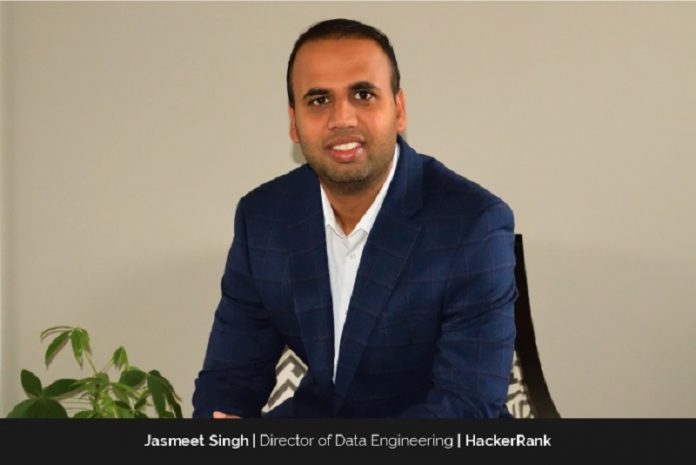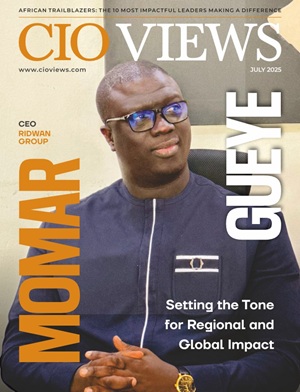
When Jasmeet Singh laid his hands on a desktop keyboard for the first time, he realized the power of technology to help him connect with anyone, learn anything, view anything, listen to music, play games, find places, and more, using just a desktop sitting at home.
That experience sparked his interest in learning more about internet networks and communication protocols, guiding him to choose Electronic and Communications as his major. While studying for his Bachelor’s degree, Jasmeet got an internship in India’s leading telecommunication company, Airtel, and seeing in action what he had learned in theory inspired him further.
“My desk during the internship was next to the customer service department and I remember when one of the internet towers fell due to a storm. Every phone at the customer service department kept receiving call after call. People were frustrated because they were not able to do their jobs, not able to study, book their travel, or chat with their loved ones abroad. I had to rush with the team to the spot to troubleshoot and fix the issue, and it made me feel important, almost like a hero,” he recalls.
Becoming an Innovator and Technology Pioneer
Jasmeet’s passion for technology grew and he went on to complete a Master’s in Electrical and Computer Engineering, following which he worked in the technology field for over 15 years with diverse organizations. What he finds most interesting about technology is its disruptive nature, that every company must now be technology first, and that technology is not only about innovation or R&D anymore, but essential for existence.
Another aspect of technology that Jasmeet loves is the constant need to keep learning new things, which keeps him engaged, and also that while lot of complexity exists into design and architecture of applications but the end user interface must be simple to enable easier adoption. He feels fortunate to have worked at some of the largest companies in the world that often come up against barriers in technology that the majority of companies would hit in the next five to 10 years.
He notes that, when working for smaller organizations or on a medium-scale problem, it helps to see how large companies solved similar problems as a starting point and then innovate. “But what do you do if you’re the largest company in the world?” he asks. “There’s a saying that necessity is the mother of invention, so the only choice is to innovate and do it insanely fast.”
Jasmeet recounts hitting such a barrier while working as the Lead engineer at Amazon Prime. Their user base was growing exponentially and so was the amount of data their systems were collecting and generating. The world was transforming into big data and AI, and the data needed to be fresh and processed in real time.
Their traditional data processing systems had hit the ceiling, but Jasmeet was fortunate to work with some of the best minds in technology. They together found innovative solutions to break the barriers of symmetric multi-processing with massively parallel processing, along with a new data design called data mesh, which is picking up a lot of steam recently. To solve the data freshness problem, they came up with the concept of federated storage. Both these solutions were highly practical and are now being adopted widely by industry.
“Technology is there to solve the business problem and your job is to match the right piece of technology to the right business problem.”
The Game-Changing Impact of Cloud Technology
Jasmeet points out that the technology industry has a track record of changing at a rapid pace mainly due to constantly evolving customer needs and is also becoming highly competitive day by day. There’s a need to build quality products faster and release new features on an almost monthly basis. Cloud technology has changed the game as customers can migrate their workloads overnight if they don’t like any aspect of your product, whether the cost, quality, or service.
But with these challenges come great opportunities, and the tech industry is no longer limited to Big Tech, as all companies, from manufacturing and commerce to restaurant and entertainment, now view themselves as tech companies. Some non-tech companies are coming up with amazing solutions using cloud, which are even better than those built by top players in the market.
“When I was working at the headquarters of a global restaurant chain, On The Border, our restaurant employee scheduling system was only 50 percent accurate as it only considered same day prior year sales while recommending a schedule. What that meant was we had locations with servers sitting idle and other locations where we did not have enough staff to meet demand, resulting in loss of revenue, higher costs, and frustrated customers,” Jasmeet recalls.
They finally solved the problem by building a scheduling system that leveraged more advanced machine learning algorithms, which considered local weather and other events, along with the same day sales in the prior year and prior week. This helped them calculate a more accurate head count needed at each location and made one of the best off-the-shelf scheduling systems obsolete.
Leveraging Technological Innovation to Impact Lives Positively
Jasmeet believes that his greatest achievement is being able to touch the lives of so many people positively, be they customers or colleagues. He shares an example of how, when working for the medical device manufacturer, Lake Region Medical in Minnesota, he put in place a solution that made their minimally invasive product even better by integrating real-time imaging technology into guidewires. This enabled surgeons to plant it more accurately and ended up saving many lives.
In another example, Jasmeet recounts how new technology solutions he put into restaurant chains enabled them to serve quality meals within 15 minutes during lunchtime, making it feasible for more people to take a break from work and enjoy warm, healthy food, as compared to vending machines or fast food.
Furthermore, the data lake solution that Jasmeet built at Amazon ensured shoppers received recommendations with the best-priced items and essential products they ordered were delivered to them on time. The digital manufacturing platform he built at HUSCO International ensured that no faulty hydraulic valve gets shipped to customers, so people can reach their destination economically and safely. Most recently, at HackerRank he’s helping build AI-first solutions to ensure every developer gets a fair shot at a high-paying tech job.
“Moving slow will hurt more than failing fast.”
Keep Learning & Stay Abreast with Emerging Technologies
Jasmeet’s determination to keep learning and staying up to date with emerging technologies helps him stay abreast with increasing competition. He was fortunate enough to have the right mentors along the way and normally attends over 10 technology conferences every year, some as a guest and others as a speaker. One of his favorite ways to learn is through networking at conferences, and he suggests keeping in touch with your network, following up with them, and sharing your thoughts and pain points to get solid advice.
Another of Jasmeet’s tips for staying up to date is to follow the right folks on LinkedIn and stay informed of new stuff as soon as it’s launched so you can start thinking about use cases and how this innovation can help solve your current and future challenges. He recalls one such example when he was about to kick start the industry 4.0 Digital Manufacturing effort at HUSCO International, which needed processing and analyzing production line sensor data in real-time.
Jasmeet noticed a new LinkedIn post from Mark Kromer, a Cloud Data Analytics leader at Microsoft, about a new data platform called Azure Data Explorer being released in preview mode. It was so much faster and cheaper than the platform we were about to deploy at his company’s that they were quickly able to pivot and save a lot of time and money as a result. “My point is that staying up-to-date can save costs and lots of time in future migrations. With our busy jobs, one of the low-hanging fruits is scrolling through your LinkedIn feed for a few minutes in a day,” he recommends.
In addition to this, Jasmeet also completes new training and certifications and encourages his team to do the same, as formal training is such an integral part of his company’s strategy that they also have a separate line item in the technology budget for training and certification and as well as seek vendors who help lift some of these costs.
“Investing time and money in learnin is the best investment.”
Leading By Example & Staying True to Values
Jasmeet’s definition of success is to achieve the intended business outcome with each initiative launched and appreciate how many lives he impacts in the process. For long-term success, he believes that it’s essential to build trust and reputation as products may evolve, but the only reason people will stick to your brand is if you stay true to your values.
“Customers nowadays don’t just look for features. They want an experience. You may be making a lot of money selling a product, but if that product is not positively impacting people’s lives, it’s all meaningless and will vanish one day. People remember legacy, not revenue numbers,” he insists.
Jasmeet maintains that good leaders lead by example, as you cannot expect others to do something if you’re not doing the same, whether it’s taking ownership, accountability, or staying true to values. Leaders set the vision, help with strategic alignment, then empower their teams to make the right decisions.
They foster a culture of innovation and collaboration, but the winning strategy comes from both directions, not always top to bottom. Leaders need to be authentic, and it is good to be vulnerable at times because that only makes us human and improves trust with the team.
The Importance of Being an Adaptable & Agile Leader
Jasmeet believes that technology leaders need to operate at all levels. For instance, if they get a ping about a high-severity issue impacting customers and need all hands on deck while preparing for their next board meeting, they must be agile enough to switch from one meeting to another. He notes that what doesn’t kill you makes you stronger and that challenges keep you engaged. Otherwise, your job can become monotonous, or you can become complacent.
“My role requires me to operate at all levels and my week usually starts with a review meeting with the executive leadership team where we discuss high-priority stuff and come up with action items. I then move on to a meeting with my direct reports, checking on project progress, meetings with stakeholders, cross-functional team leaders, etc. A good portion of my day goes in technical strategy development, planning future quarters, architecture design reviews, and coaching,” he explains.
Jasmeet maintains a work-life balance by setting boundaries, which is easier said than done. There are days when he feels called to take care of work more than family and vice versa, and his most effective strategy is to block out time on his calendar for important activities like workouts, lunch, dinner, and family, with the understanding that his colleagues can call him in an emergency.
“Blocking my calendar just makes people cognizant and pick other available times for meetings. I also like to plan my week. On Sunday nights, I open my work laptop for 30 minutes, reschedule meetings based on the latest priorities, and schedule messages in advance to be sent on Monday morning using the schedule later feature,” he elaborates.
Jasmeet stays motivated to achieve goals by creating milestones, working hard towards the milestone, and also making sure he rewards himself, whether it’s a vacation with family or some other activity he’s always wants to indulge in. “Celebrating success from time to time keeps me sane,” he remarks.
Don’t Give Up If You Face Resistance to Change
While he’s had a truly exciting journey with tremendous success, Jasmeet feels he’s not yet achieved everything he wants and doesn’t think he ever will, because his dreams keep expanding with every milestone. He hopes to become one of the most influential technology leaders, so he can positively impact the maximum number of lives possible.
The biggest roadblock he’s seen is people’s resistance to change. “Change is hard for everyone, so you need to plan it carefully, identify the supporters and resistors early on, and build a strategy to deal with resistors. In this, early alignment and executive support will help. Before throwing too many resources into an initiative, make sure the supporters-to-resistors ratio is in your favor, otherwise, the initiative will be sabotaged. But you cannot go too slow either and that’s where it becomes an art,” he observes.
Jasmeet’s message to aspiring business leaders is to keep learning and growing, match your role with your interests and passion, embrace change, be patient, and more importantly, take intelligent risks. If you know you’re doing the right thing, don’t give up if you see resistance to your initiative. Wait and try multiple times if you have to. Sometimes the technology you’re trying to introduce is too much for people to swallow, so it is alright to slow down but not give up. If what you discovered is important for your organization, it will be needed. It’s just a matter of when.
“Create a balance between people and processes, trust your people to create the right processes, as a process only works if people follow.”




















